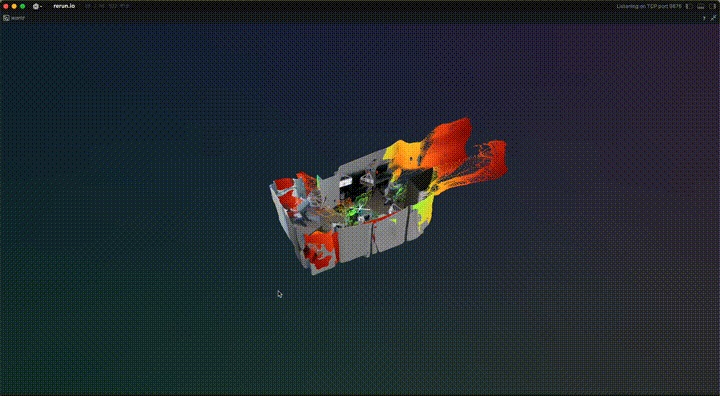A miniature version of dust3r only for performing inference. This makes it much easier to use without needing the training/data/eval code. Tested on Linux, Apple Silicon Macs, and Windows (Thanks @Vincentqyw)
Easily installable via pip
pip install mini-dust3rA hosted demo can be found on huggingface here
or from source using Pixi
git clone https://github.com/pablovela5620/mini-dust3r.git
pixi run gradio-demoYou can also just use rerun demo directly with
pixi run rerun-demoUses Rerun to visualize the outputs
import rerun as rr
from pathlib import Path
from argparse import ArgumentParser
import torch
from mini_dust3r.api import OptimizedResult, inferece_dust3r, log_optimized_result
from mini_dust3r.model import AsymmetricCroCo3DStereo
def main(image_dir: Path):
if torch.backends.mps.is_available():
device = "mps"
elif torch.cuda.is_available():
device = "cuda"
else:
device = "cpu"
model = AsymmetricCroCo3DStereo.from_pretrained(
"nielsr/DUSt3R_ViTLarge_BaseDecoder_512_dpt"
).to(device)
optimized_results: OptimizedResult = inferece_dust3r(
image_dir_or_list=image_dir,
model=model,
device=device,
batch_size=1,
)
log_optimized_result(optimized_results, Path("world"))
if __name__ == "__main__":
parser = ArgumentParser("mini-dust3r rerun demo script")
parser.add_argument(
"--image-dir",
type=Path,
help="Directory containing images to process",
required=True,
)
rr.script_add_args(parser)
args = parser.parse_args()
rr.script_setup(args, "mini-dust3r")
main(args.image_dir)
rr.script_teardown(args)def inferece_dust3r(
image_dir_or_list: Path | list[Path],
model: AsymmetricCroCo3DStereo,
device: Literal["cpu", "cuda", "mps"],
batch_size: int = 1,
image_size: Literal[224, 512] = 512,
niter: int = 100,
schedule: Literal["linear", "cosine"] = "linear",
min_conf_thr: float = 10,
) -> OptimizedResult:Consists of
- image_dir_or_list - Path to the directory containing images or a list of image paths
- model - The Dust3r model to use for inference
- device - device to use for inference ("cpu", "cuda", or "mps")
- batch_size - The batch size for inference. Defaults to 1.
- image_size - The size of the input images. Defaults to 512.
- niter - The number of iterations for the global alignment optimization. Defaults to 100.
- schedule - The learning rate schedule for the global alignment optimization. Defaults to "linear"
- min_conf_thr - The minimum confidence threshold for the optimized result. Defaults to 10.
@dataclass
class OptimizedResult:
K_b33: Float32[np.ndarray, "b 3 3"]
world_T_cam_b44: Float32[np.ndarray, "b 4 4"]
rgb_hw3_list: list[Float32[np.ndarray, "h w 3"]]
depth_hw_list: list[Float32[np.ndarray, "h w"]]
conf_hw_list: list[Float32[np.ndarray, "h w"]]
masks_list: Bool[np.ndarray, "h w"]
point_cloud: trimesh.PointCloud
mesh: trimesh.TrimeshConsists of
- K_b33 - camera intrinsics of shape (b33)
- world_T_cam_b44 - camera to world transformation matrix of shape b44 in OpenCV convention X - Right Y - Down Z - Forward (RDF)
- rgb_hw3_list - list of RGB images shape (list[hw3])
- depth_hw_list - list of normalized depth maps shape (list[hw])
- conf_hw_list - list of normalized confidence values (list[hw])
- mask_list - list of masks (list[hw])
- point cloud - as a trimesh pointcloud object
- mesh - as a trimesh mesh object
Full credit goes the Naver for their great work on

